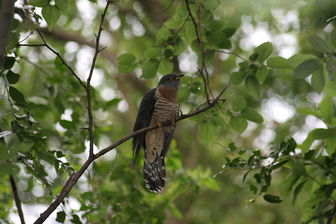Red-chested Cuckoo
It is found in Angola, Benin, Botswana, Burundi, Cameroon, Central African Republic, Chad, Republic of the Congo, Democratic Republic of the Congo, Ivory Coast, Equatorial Guinea, Ethiopia, Gabon, Gambia, Ghana, Guinea, Guinea-Bissau, Kenya, Lesotho, Liberia, Malawi, Mali, Mozambique, Namibia, Nigeria, Rwanda, Senegal, Sierra Leone, Somalia, South Africa, Sudan, Swaziland, Tanzania, Togo, Uganda, Zambia, and Zimbabwe. In Southern Africa it is a common breeding migrant, found throughout the area except for the drier west.

Original source: Monkey Boy from Johannesburg, South Africa
Author: Monkey Boy from Johannesburg, South Africa
The Red-chested Cuckoo is classified as Least Concern. Does not qualify for a more at risk category. Widespread and abundant taxa are included in this category.
The Red-chested Cuckoo (Cuculus solitarius) is a species of cuckoo in the Cuculidae family. It is a medium-sized bird (28 to 30 cm), found in Africa south of the Sahara. More
The Red-chested Cuckoo (Cuculus solitarius) is found in Africa - specifically south of the Sahara. It is common throughout Southern Africa, except for the drier west. More
The Red-chested cuckoo is mainly found in the eastern half of southern Africa, and is quite common in protected areas, living in a wide range of habitats. It feeds mostly on invertebrates, particularly hairy caterpillars but also grasshoppers and beetles, amongst others. It mostly parasitizes members of Muscicapidae (robins, thrushes, flycatchers, etc. More
The Red-chested Cuckoo is a Southern African bird that belongs to the cuculidae bird family group which includes birds such as Old World Cuckoos, Malkohas. The description for the Red-chested Cuckoo (Latin name Cuculus solitarius) can be found in the 7th Edition of the Roberts Birds of Southern Africa. The Cuculus solitarius can be quickly identified by its unique Roberts identification number of 377 and the detailed description of this bird is on page 205. More
a picture of the Red-chested Cuckoo on page 208. The Red-chested Cuckoo belongs to the family of birds classified as cuculidae. The map of the Kruger you see on this page shows the areas (coloured orange) where this bird has been identified. The basic information was provided by the Avian Demographic Unit based at UCT and I created the maps from that information ... More
For the purposes of our bird news services, Red-chested Cuckoo is classed as ungraded: species which are unlikely to appear as wild birds in Britain or Ireland (Note that rarity levels are currently applied nationally and may not reflect local variations in abundance. More
The Red-chested Cuckoo subsists mainly on caterpillars, other insects and some seeds. Breeding takes place from October to January, and is dependent on the breeding times of the host species, as the Red-chested cuckoo if a parasite, which lays it's eggs in other birds nests. It parasites a number of species, Cape Robin-Chat and Cape Wagtail being most often recorded. More
* Red-chested Cuckoo, an African bird * Red-chested Flowerpecker, an Asian bird * Red-chested Flufftail, an African bird in the Rallidae family * Red-chested Goshawk, an African bird in the Accipitridae family * Red-chested Owlet, an African bird in the Strigidae family * Red-chested Sunbird, an African bird in the Nectariniidae family * Red-chested Swallow, an African bird in the Hirundinidae family Disambig gray. More
call of the Red-chested Cuckoo and the "I'm so sad" call of the Black Cuckoo are well know to city and country folk alike, even though they may never have seen the birds. The calling of the male cuckoos continues through November into December, but then tails off, even though the birds usually remain in the region until March or April. Female cuckoos call much less and are incredibly secretive. More
red-chested cuckoo resting in a tree. Pietermaritzburg, KwaZulu Natal Province, South Africa David Nowell 27 December 2007 22 weeks ago 4 * Red-chested Cuckoo Frontal view of a perched male Samburu-Buffalo Springs National Reserves, Kenya Robert Wynands 22 December 2002 22 weeks ago 1.5 Sounds 1 recording * Call. 50 east of Rundu. 12:48am. More
Family : Cuculidae
Genus : Cuculus
Species : solitarius
Authority : Stephens, 1815

